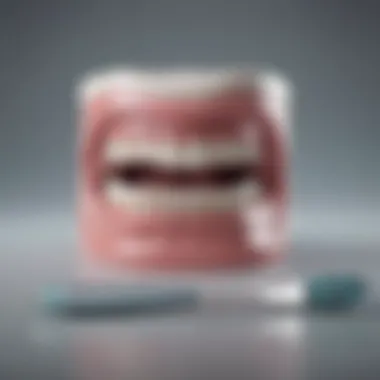Dental Hygiene Therapy: Key Elements of Preventive Care


Intro
Dental hygiene therapy plays a crucial role in maintaining oral health. It goes beyond mere brushing and flossing, influencing overall well-being significantly. The impact of good dental hygiene stretches into various aspects of life, including physical health and social interactions. The pursuit of preventive care allows individuals to combat dental diseases before they manifest.
Understanding this therapy involves acknowledging the contributions of oral health professionals. These experts not only provide essential care, but also educate patients about maintaining their own oral hygiene. The integration of patient education serves as a key component in dental hygiene therapy, promoting informed decisions that lead to better health outcomes.
In addition, current research illuminates trends in the discipline. Innovations in tools and techniques pave the way for more effective practices, ensuring patients receive the best possible care. As the landscape of dental care continues to evolve, being knowledgeable about these changes is essential for both practitioners and patients alike.
Understanding Dental Hygiene
Dental hygiene is more than just a routine; it signifies a crucial aspect of maintaining oral health and overall well-being. Clear understanding of dental hygiene practices can significantly reduce the risk of developing oral diseases. It encapsulates techniques and measures tailored to keep the mouth, teeth, and gums healthy. A firm grasp of this subject not only benefits individuals but also serves the community as a whole.
Definition and Importance
Dental hygiene refers to the practice of maintaining clean teeth and gums to prevent dental issues such as cavities, gum disease, and bad breath. It encompasses several activities like brushing, flossing, and regular dental check-ups. Adequate dental hygiene also involves awareness of dietary choices that impact oral health. Effective dental hygiene practices can lead to improved health outcomes, including reduced risk of chronic diseases, as oral health is closely linked to conditions such as diabetes and heart disease.
The importance of dental hygiene cannot be overstated. According to the World Health Organization, oral diseases affect nearly 3.5 billion people globally. Emphasizing hygiene practices helps mitigate these statistics. Regular practices empower individuals allowing them to take control of their oral health.
Historical Perspective
The concept of dental hygiene has evolved over centuries. Early records show that ancient civilizations utilized rudimentary tools for oral care. The Egyptians had methods involving toothpicks made from wood and animal bones, while the Chinese developed the first bristle toothbrush around the 15th century. Over the years, awareness about dental hygiene has grown, fueled by advancements in dental science and education.
In the mid-20th century, there was a notable shift in public perception of dental hygiene. Campaigns promoting fluoride use and regular dental visits transformed practices, leading to a significant decline in dental caries.
Now, dental hygiene is a recognized profession, with dental hygienists playing a pivotal role in preventive care. They not only perform cleanings and assessments but also provide valuable education on maintaining oral health. This history emphasizes the essential nature of dental hygiene as a continuously adapting practice in response to public needs and scientific advancements.
Goals of Dental Hygiene Therapy
The goals of dental hygiene therapy are centered on safeguarding oral health and promoting a comprehensive understanding of wellness among patients. This section discusses various aims, including disease prevention and maintaining overall health. Effective dental hygiene plays a pivotal role in enhancing lifestyle and quality of life.
Preventing Oral Diseases
Preventing oral diseases is a primary objective of dental hygiene therapy. Poor oral hygiene can lead to conditions like cavities, gum disease, and even oral cancer. By focusing on prevention, dental hygienists aim to reduce oral health issues significantly. Regular dental cleanings, along with educational advice, empower patients to maintain their oral health at home.
To prevent these diseases, different strategies are employed:
- Regular Check-ups: Routine visits to a dentist help to monitor oral health, detect potential problems early, and provide necessary treatments before they escalate.
- Sealants and Fluoride: Applying sealants protects against decay, while fluoride remineralizes teeth, making them stronger against acid attacks.
- Personalized Care Plans: Tailoring oral care according to individual needs helps in addressing specific issues each patient might face.
Creating awareness about effective brushing and flossing techniques also plays a crucial role in this prevention strategy. This can lead to a noticeable decline in the prevalence of oral diseases.
Promoting Overall Health
The second goal of dental hygiene therapy is promoting overall health beyond just oral considerations. The mouth is a window to the body's overall health, and many systemic conditions are linked to poor oral hygiene. For instance, respiratory infections, cardiovascular diseases, and diabetes can be exacerbated by inadequate dental care.
Some significant benefits of this aspect include:
- Systemic Disease Prevention: Many studies suggest that maintaining good oral health can reduce the risk of diseases, such as heart disease, by decreasing inflammation and bacteria in the mouth.
- Improved Quality of Life: Good oral hygiene often leads to better self-esteem and confidence through a healthy smile. This can positively influence social interactions and mental well-being.
- Nutritional Health: Maintaining oral health helps in better chewing and swallowing, thereby enhancing nutritional intake.
Thus, the interplay of dental hygiene with broader health aspects illustrates its vital importance. Educating patients about this connection can increase their motivation to adhere to proper oral care practices.
Key Components of Dental Hygiene Therapy


Dental hygiene therapy integrates a variety of critical components that collectively aim to maintain oral health and prevent dental diseases. Understanding these components is paramount for both oral health professionals and patients. Good dental hygiene helps not only to keep teeth and gums healthy but also plays a role in overall well-being. This section delves into the specific elements that form the foundation of effective dental hygiene therapy.
Oral Examination and Assessment
An oral examination is one of the first steps in dental hygiene therapy. During this process, a dental hygienist evaluates the condition of a patient's teeth, gums, and overall oral health. Assessments are thorough and typically involve checking for signs of gum disease, cavities, and any other potential issues. The results guide the hygienist in creating a personalized treatment plan that addresses the specific needs of the patient.
This assessment is vital as it helps in early detection of problems. Catching issues early can lead to simpler and less invasive treatments. It also helps in educating patients about their own oral health status, fostering a proactive approach to care.
Preventive Treatments
Preventive treatments are designed to stop dental issues before they develop. This includes a range of services and materials that aid in protecting teeth from decay and disease. Preventive care is crucial in reducing long-term costs associated with dental treatments and improving overall quality of life.
Fluoride Application
Fluoride application is widely recognized for its effectiveness in preventing tooth decay. This treatment involves applying a fluoride gel, foam, or varnish directly to the teeth. Fluoride works by strengthening tooth enamel, making it less susceptible to acid attacks from plaque bacteria and sugars in the mouth. A key characteristic of fluoride is its ease of application and quick action, making it a popular choice among dental professionals.
Additionally, fluoride is beneficial because it can reverse early signs of decay. This unique feature sets it apart from many other preventive measures. However, some caution is advised against excessive use, especially in children, as it can lead to dental fluorosis. Despite this, its advantages in reducing cavity rates make fluoride applications a standardized practice in preventive dental care.
Sealants
Sealants are another effective preventive treatment, specifically for molars and premolars that have deep grooves where food particles can easily get trapped. Sealants are thin, protective coatings applied to the chewing surfaces of these teeth. Their primary benefit is to create a smooth surface that is easier to clean, thereby reducing the risk of cavities. A notable aspect of sealants is their longevity; they can last several years with proper maintenance.
However, like any treatment, sealants do have their limitations. They are primarily recommended for children and teens, as adults may not benefit as much from them. Nonetheless, their role in preventing caries in at-risk populations is significant, affirming their value in comprehensive preventive dental strategies.
Patient Education
Patient education is an integral component of dental hygiene therapy. It involves informing patients about proper oral health habits, such as brushing techniques, flossing, and dietary choices that impact oral health. Education empowers individuals to take responsibility for their own dental hygiene. The more informed patients are, the better decisions they can make, potentially leading to healthier outcomes.
Professionals use various tools and methods to educate patients, including brochures, demonstrations, and personalized advice. The ultimate goal is to instill lifelong habits that decrease the risk of dental diseases.
In summary, the key components of dental hygiene therapy encompass careful examinations, effective preventive treatments, and robust patient education. Together, these elements create a comprehensive approach to maintaining oral health. The interconnection between each component enhances the effectiveness of dental hygiene therapy, ensuring optimal outcomes for patients.
The Role of Dental Hygienists
Dental hygienists play a crucial role in the landscape of dental care. They are often the first line of defense against oral diseases, armed with both knowledge and skills essential for preventive care. Their unique position allows them to offer valuable insights to patients, ensuring that oral health is prioritized in daily routines.
Scope of Practice
The scope of practice for dental hygienists varies by region, yet several core responsibilities remain consistent. Primarily, they perform oral hygiene assessments, conduct teeth cleaning, and apply preventive treatments like fluoride and sealants.
In many places, dental hygienists can also take radiographs to assist in evaluating a patient's dental health. They are trained to provide educational advice to patients, which empowers individuals to take charge of their oral hygiene. This education can include guidance on effective brushing techniques, dietary recommendations, and the importance of regular dental check-ups.
Furthermore, their training allows hygienists to recognize early signs of oral diseases, such as periodontal disease or oral cancer. This early detection can lead to timely interventions, ultimately reducing the burden of dental issues on both patients and the healthcare system.
Collaboration with Dental Professionals
Collaboration is vital in healthcare, and dental care is no exception. Dental hygienists work closely with dentists and other oral health professionals to provide comprehensive care. This teamwork ensures that patients receive well-rounded assessments and treatment plans tailored to their specific needs.
By sharing observations about a patient's dental health, hygienists contribute to a collaborative environment where treatment goals are agreed upon. For instance, if a hygienist notes developing cavities or the onset of gum disease during a cleaning, they can promptly communicate this to the dentist. This seamless communication aids in developing a proactive approach to treatment, preventing the escalation of potential issues.
The interplay between hygienists and dentists also enhances the patient experience. Patients often feel more at ease when they know that their oral health providers are aligned, maximizing the effectiveness of dental visits. Moreover, this collaboration emphasizes the importance of comprehensive care, where preventative strategies are integrated into the overall treatment plan.
In summary, the role of dental hygienists is multifaceted, merging clinical skills with patient education and teamwork. Their contributions are indispensable in ensuring effective dental care and promoting overall health.


Current Trends in Dental Hygiene Therapy
The landscape of dental hygiene is continually evolving, and understanding current trends is crucial. Staying updated with these trends can help professionals in the field enhance their practice, lead to improved patient outcomes, and ensure adherence to modern standards. Among the notable trends in dental hygiene therapy are technological advancements and the integration of telehealth services, both of which have profound implications for patient care.
Technological Advancements
Digital Imaging
Digital imaging has transformed the way dental professionals assess and treat patients. Unlike traditional X-rays, digital imaging offers a faster, more efficient way to capture and analyze images of the mouth. This technology is notable for its high-resolution capabilities, allowing for detailed examination of dental structures. The key characteristic of digital imaging is its ability to reduce radiation exposure, making it a safer choice for patients.
Additionally, the instant availability of images enhances the workflow in a dental practice. It enables real-time communication between dental hygienists and other team members, leading to quicker decision-making and increased accuracy in diagnoses. Digital imaging is also interactive; three-dimensional interpretations can provide clearer insights into dental conditions, which is particularly beneficial when planning treatments.
Some advantages of digital imaging include:
- Lower radiation doses compared to traditional methods.
- Faster image processing and retrieval.
- Eco-friendliness due to reduced use of chemicals.
However, dependency on technology can pose challenges. Technical malfunctions or system failures could disrupt procedures. Understanding how to mitigate these risks is essential for dental professionals.
Intraoral Scanners
Intraoral scanners represent another significant advancement in dental hygiene therapy. These devices are used to capture precise digital impressions of a patient’s teeth and gums. This is a game changer for accurate fittings associated with restorative dentistry, orthodontics, and prosthetics. A key characteristic of intraoral scanners is their ability to provide immediate visual feedback to both the clinician and the patient. This immediate response can enhance patient engagement and comfort during procedures.
The unique feature of intraoral scanning lies in its accuracy and speed. Traditional impression methods can be uncomfortable for patients and may result in inaccuracies. In contrast, intraoral scanners can produce highly detailed 3D images without the messiness of impression materials. The benefits include:
- Enhanced patient comfort with non-invasive scanning techniques.
- Improved efficiency in creating dental appliances or restorations.
- Excellent documentation capabilities for monitoring orthodontic treatments over time.
Like any technology, there are downsides. The initial investment in intraoral scanning technology can be high, and the learning curve may require additional training for staff and practitioners.
Telehealth in Dental Care
Telehealth is increasingly relevant in dental hygiene, allowing for remote consultations and follow-up care. This trend has gained traction particularly due to the COVID-19 pandemic, which necessitated alternative methods for patient interactions. Telehealth can improve access to dental hygiene services, especially for those in remote or underserved areas.
The key aspects of telehealth in dental care include:
- Virtual consultations that facilitate ongoing patient education and support.
- Remote monitoring of patients' oral health through wearable devices or mobile applications.
One of the significant benefits of telehealth is increased accessibility to dental care. Patients with mobility issues or those living far from urban centers can receive guidance without needing to travel. Moreover, this trend encourages continuity of care, as regular check-ins can lead to better oral health outcomes.
However, it is important to recognize limitations. Not all dental issues can be assessed or treated remotely. The absence of physical examinations can restrict the ability to make accurate diagnoses.
In summary, embracing current trends in dental hygiene therapy can lead to significant improvements in patient care. Keeping abreast of technological advancements like digital imaging and intraoral scanning, along with the rise of telehealth services, offers insights that can drive better oral health and facilitate a more effective preventive care approach.
Challenges and Barriers
In the realm of dental hygiene therapy, understanding the challenges and barriers is crucial. These obstacles can significantly impede access to care and affect public awareness about oral health. By exploring these issues, we can identify ways to improve outcomes in preventive care.
Access to Care
Access to dental care is a multi-faceted issue influenced by numerous factors. Economic constraints, geographic location, and systemic inequities contribute to whether individuals can receive the dental care they need. In many rural areas, residents may have limited access to dental professionals. Transportation barriers can further complicate the situation, especially for those without personal vehicles.
Additionally, financial issues play a central role. Dental care is not always covered by health insurance, leading to high out-of-pocket expenses that many cannot afford. As a result, basic preventive services may be neglected. Individuals often prioritize other health expenditures, leaving dental visits on the back burner, which can lead to worsened oral health conditions.


Enhancing access to care requires multi-layered solutions, such as community health initiatives, telehealth provisions, and increased funding for dental programs. Programs designed to deliver dental care in schools and community centers can also help reach underserved populations.
Public Awareness
Public awareness about the importance of dental hygiene is another significant barrier to effective dental care. Many people are not fully informed about how dental health relates to overall health. Dental hygiene education often does not reach the depth required to instill healthy habits in the population.
Studies often reveal misconceptions surrounding dental hygiene. Some individuals may believe that dental visits are only necessary when a visible problem arises. Others might not understand the significance of regular cleanings and check-ups in preventing severe dental diseases.
Increasing public awareness can be achieved through targeted campaigns and educational programs. It's essential to convey the message that preventive care is crucial and that small, regular steps can lead to major health benefits. Collaboration between health organizations, educational institutions, and local communities can create a robust platform for spreading knowledge.
"Preventive dental care is not merely a luxury; it serves as a cornerstone for lifelong health. Without it, individuals face unnecessary suffering and increased health costs."
To effectively tackle the challenges in access to care and raise public awareness, a comprehensive approach will be necessary. By addressing these barriers, we can promote a more health-conscious society.
Future Directions in Dental Hygiene Therapy
The landscape of dental hygiene therapy is constantly evolving. Understanding future directions in this field is essential for practitioners and educators. This discussion encompasses the increasing need for adaptive standards and an emphasis on ongoing research and innovation. As dental hygiene therapy continues to adapt to societal changes and technological advancements, recognizing and anticipating these trends fosters a proactive approach to care.
Evolving Practice Standards
The practice standards for dental hygiene are not static. They are subject to stringent evaluation and improvement through various governing bodies. As the field progresses, the integration of more comprehensive protocols is becoming necessary. These standards guide practitioners in maintaining the high quality of care required for effective dental hygiene.
Key elements include:
- Education and Certification: Ongoing education is mandatory to keep up with advancements. Dental hygienists must engage in continual learning through workshops and certifications.
- Scope of Practice: There is a push towards expanding the scope of what dental hygienists can perform. This can empower them to take on more responsibility in patient care.
- Interprofessional Collaboration: The necessity of teamwork among various health professionals continues to rise. Hygiene practices increasingly require coordinated efforts with dentists, physicians, and public health officials.
Implementing these evolving standards leads to enhanced patient outcomes. Practicing hygienists will be better equipped to manage patient care effectively, thus advancing the overall health of the community.
Research and Innovation
Research plays a critical role in shaping the future of dental hygiene therapy. The field benefits significantly from rigorous studies and innovative practices. By focusing on emerging techniques and technologies, dental hygiene can remain relevant and effective.
Important areas of research and innovation include:
- Materials Science: Development of new biomaterials for preventive and restorative treatments continues to improve clinical outcomes.
- Technology Integration: Innovations such as artificial intelligence and machine learning can aid in diagnostic and treatment planning processes. These emerging technologies enable practitioners to provide more precise and efficient care.
- Preventive Strategies: Ongoing studies into effective preventive care measures can lead to new approaches to address oral diseases. Understanding the long-term benefits of preventive therapies is critical.
Research and innovation combine to offer powerful tools. As new methods emerge, the approach to dental hygiene therapy becomes more effective and patient-centered.
In summary, future directions in dental hygiene therapy illustrate the importance of developing practice standards and embracing research and innovation. As we look ahead, it is clear that a commitment to adapting and improving practices will yield substantial benefits for both practitioners and patients.
The End
In summary, the conclusion of this article underscores the vital role that dental hygiene therapy plays in fostering oral health and preventing disease. Recognizing the significance of this therapy is paramount for both practitioners and patients. A well-structured dental hygiene regimen not only maintains healthy oral conditions but also contributes positively to overall health.
Summary of Key Points
The key points outlined throughout the article encapsulate crucial aspects of dental hygiene therapy:
- Preventive Care: Routine cleanings and assessments are essential to prevent conditions such as gum disease and tooth decay.
- Role of Professionals: Dental hygienists are central to the implementation of hygiene protocols and effective patient care.
- Patient Education: Increasing public awareness regarding proper dental hygiene practices is imperative.
- Emerging Trends: Technologies like digital imaging and telehealth are reshaping the delivery of dental care.
- Challenges: Issues such as access to care and varying levels of public knowledge pose ongoing challenges for the field.
This synthesis illustrates not only the multidimensional nature of dental hygiene therapy but also its far-reaching impact on public health.
Call for Continued Education
Continued education in dental hygiene therapy is crucial for the advancement of the field. Health professionals must stay informed about the latest research, techniques, and technologies to enhance their practice.
- Professional Training: Ongoing professional development and specialized training should be encouraged to maintain high standards of care.
- Public Workshops: Community-led workshops can help educate the public about the importance of oral hygiene and preventive practices.
- Resource Utilization: Utilizing resources from institutions like the American Dental Association and other professional organizations is essential for staying up to date.
"Education is the most powerful weapon which you can use to change the world."
By fostering an environment of learning and growth, stakeholders can ensure that dental hygiene therapy continues to evolve, adapting to new challenges and innovations in dental care.







